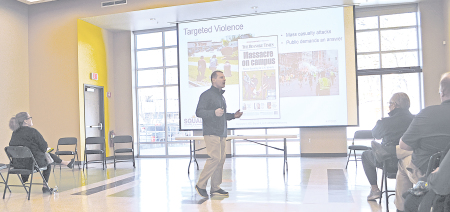How To Carnegie
Published:
February 17th, 2022
 The Guernsey Memorial Library in Norwich. (Photo from the Guernsey Memorial Library Facebook page)
The Guernsey Memorial Library in Norwich. (Photo from the Guernsey Memorial Library Facebook page)
By Connie Dalrymple, Guernsey Memorial Library Director
The name Carnegie conjures multiple images to mind. Most people probably think first of Carnegie Hall, the prestigious Manhattan music venue. Others may think of Carnegie Mellon University in Pittsburgh. What may not immediately come to the fore is that the existence of both of these institutions is due to a Scottish immigrant named Andrew Carnegie. This is sad, but not terribly surprising, since industrialist and philanthropist Andrew Carnegie has been dead for more than 100 years.
Carnegie, born in 1835, emigrated with his parents to the United States at the age of 12. As was often the case in those days, the young immigrant had to work to help support his family. By turns a bobbin boy and a steam engine operator in a cotton mill, then a telegraph messenger, Carnegie was an ambitious lad who came to frequent the personal library of Colonel James Anderson, which was opened for the betterment and pleasure of working boys on Saturday evenings. The experience was so important to Carnegie that he vowed that if he should ever be in a position he would do what he could to see that “other poor boys might receive opportunities similar to those for which we were indebted to the noble man.”
Carnegie more than made good on that promise. He eventually became involved with railroads, oil, and steel, amassing a fortune and becoming one of the richest people in the country. While his personality and life were not without controversy, his philosophy on life has had an impact on millions in the United States and around the world. Carnegie thought dying rich was a disgrace and that one should spend the first third of one’s life becoming educated, the second third pursuing wealth, and the final third using that wealth to benefit society.
In Carnegie’s case, that meant giving away hundreds of millions of dollars to philanthropic causes before his death in 1919, including providing funding to help build thousands of public libraries so that others could pursue their educations as he had once done. There are two of these Carnegie libraries in our local Four County Library System. Binghamton Public Library was in operation from 1904 until 2002 and now is Broome County Public Library, operating out of a different facility. Skene Memorial Library in Fleischmanns is still in operation.
While not everyone is so lucky as to be able to boast of a local Carnegie library, each individual public library is the heart, pride, and joy of its community. Here in Norwich, Guernsey Memorial Library was established through the bequest of Mrs. William B. Guernsey in 1901. The original building was razed in 1967 for safety reasons and replaced by the current building, dedicated in 1969. The adjoining park was established in 1982.
All buildings require work at some point because of changing tastes and changing times. For example, my father added an indoor bathroom to his childhood home in the 1950’s. The previous necessary, whether it was kept “just in case” or because my family worried that the indoor facilities were a fad, featured a state-of-the-art two-seater, was renovated in the 1970’s and existed until Dad got a wild hair, tearing down and hauling it away in 1997. As library director, I must carry my father’s genetic predisposition to be fixated on loos, since I led Guernsey’s restroom renovation in 2019. Now we’re preparing for some even more exciting changes.
The past couple of decades have seen many changes in the way libraries are used. Much more of the library’s business is conducted electronically and the content is increasingly online, as well. In addition, people-focused space where folks can receive tutoring, have meetings, and attend programs is becoming more important. With these changes in mind, Guernsey Memorial Library has engaged Holmes King Kallquist & Associates, a firm with plenty of public library experience, to help plan how our facility can be adjusted to better suit the changing needs of our community.
The library will use several sources of funding to accomplish these renovations. Two sources are local; there are some funds left over from previous years’ operating budgets, and Wilhelmina Henley left the library a generous bequest when she passed in 2010, which the Board has carefully invested and grown. An important source of funding will be New York State’s Library Construction Aid, which allows for the reimbursement of up to 90 percent of qualifying construction costs for public libraries in economically distressed communities.
State Governor Kathy Hochul’s recent Executive Budget proposal endangers funding for this vital program. For the second year in a row, the Executive Budget includes a cut of $20 million to the New York State Library Construction Aid program, reducing the total program to less than half at $14 million for the entire state. This would mean that the total allocation for the Four County Library system would be only $400,000, which is grossly inadequate for libraries struggling to update their aging infrastructure so that they can continue to serve their communities.
This is where you and Andrew Carnegie come in. Andrew Carnegie is no longer building libraries. We are on our own and none of us as individuals have the kind of resources that he could draw on. We can, however, continue his legacy of supporting education and thinking philanthropically by contacting our state legislators and asking them to support the restoration of complete funding to the New York State Library Construction Aid program.
If you’d like to do your part, call, write, or email your state legislators or take a moment to visit the following website: https://www.nyla.org/4DCGI/cms/review.html?Action=CMS_Document&DocID=58&&menukey=advocacy. Andrew Carnegie would be proud of this kind of spirit of community.
Comments








